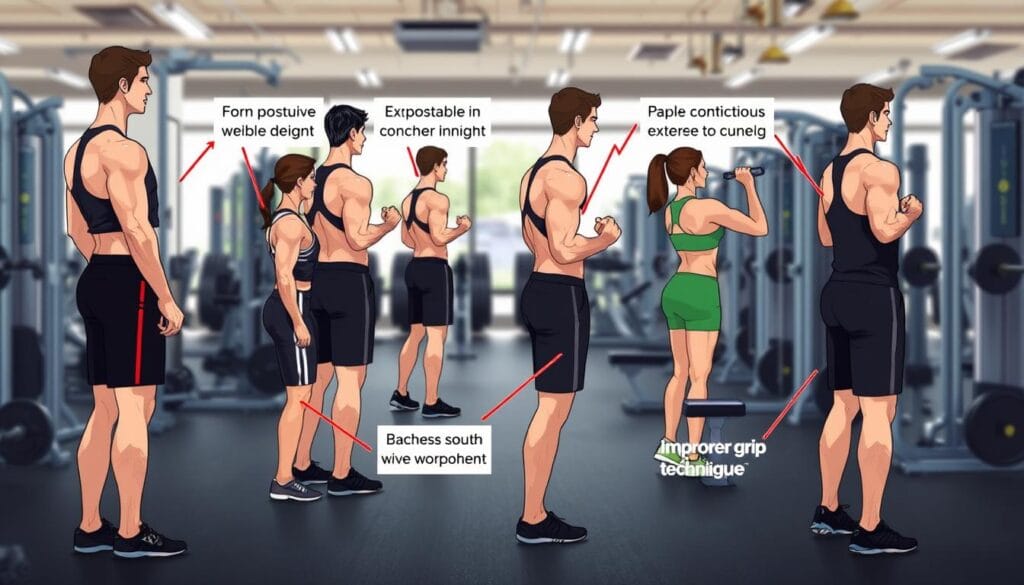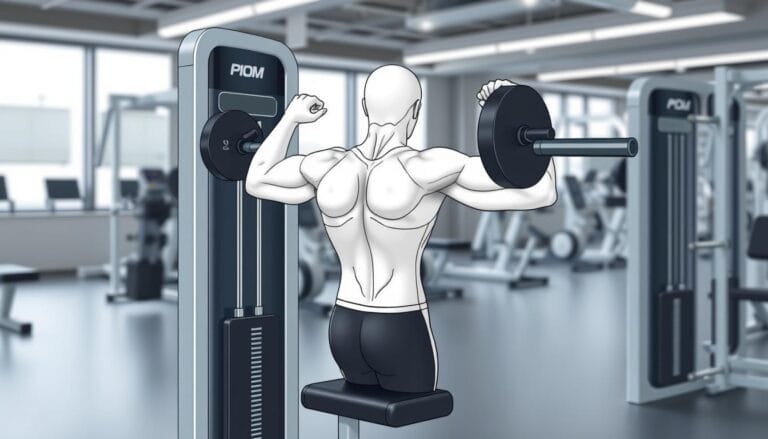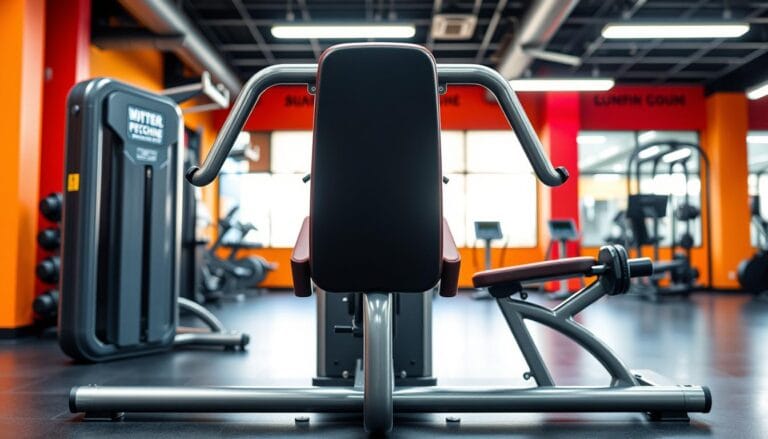Cable Pulls for Back Muscles
Every fitness journey starts with a moment of personal transformation. For me, discovering cable pulls for back exercise equipment changed everything. The consistent tension and versatility of cable machines revolutionized my workout routine.
Cable machines offer something traditional weights cannot: continuous muscle engagement throughout each movement. Unlike free weights that rely on gravity, cable machines provide constant resistance. This challenges your muscles from start to finish, leading to more effective muscle activation and greater strength gains.
Whether you’re a beginner or an experienced athlete, cable back exercises can dramatically improve your training. With the ability to perform dozens of exercises on a single machine, you’ll unlock new possibilities for muscle development and overall fitness.
In this comprehensive guide, you’ll learn how to harness the power of cable machines to build a strong, defined back. We’ll explore techniques, equipment, and workout strategies that will transform your approach to back training.
Get ready to discover why cable pulls are the secret weapon for creating a powerful, sculpted back. This back will turn heads and build real functional strength.
Table of Contents
Understanding Back Muscle Anatomy and Function
Your back is made up of many muscles that are key for upper body strength. Knowing about these muscles helps you create better back exercises and avoid injuries.
The human back has 40 muscles (20 pairs) that help with movement, posture, and physical performance. These muscles are divided into three main groups: superficial, intermediate, and intrinsic.
Upper and Lower Trapezius Muscles
The trapezius muscle has three parts: upper, middle, and lower. Each part helps with different shoulder and head movements. Working these muscles can make your shoulders stronger and give you a better upper back shape.
- Upper trapezius: Elevates and rotates the shoulder blades
- Middle trapezius: Retracts the shoulder blades
- Lower trapezius: Assists in downward rotation of shoulder blades
Latissimus Dorsi and Teres Major
The latissimus dorsi, or “lats,” are the biggest muscles in the upper back. They help create the “V-taper” shape when you work them through resistance training.
| Muscle | Primary Function | Training Impact |
|---|---|---|
| Latissimus Dorsi | Arm adduction and shoulder extension | Creates wider back appearance |
| Teres Major | Assists in arm movement | Supports shoulder rotation |
Erector Spinae Group
The erector spinae group includes three muscles: spinalis, longissimus, and iliocostalis. These muscles are vital for keeping the torso straight and supporting daily activities, especially hip hinge movements.
“Strength does not come from physical capacity. It comes from an indomitable will.” – Mahatma Gandhi
Knowing about these muscle groups helps you create better upper body strength training plans. This way, you can build muscle and lower injury risk.
Benefits of Using Cable Machines for Back Training
Cable machines change the game for back training. They offer benefits that free weights can’t. These machines, like lat pulldown and seated row, focus on specific muscles with steady tension and precise movements.
The main perks of cable back exercises are:
- Constant muscle tension throughout the entire range of motion
- Enhanced muscle activation and growth potential
- Reduced injury risk due to controlled movement
- Greater exercise variety and muscle targeting
Cable machines are great at targeted muscle stimulation. They keep the resistance steady, making your back muscles work harder with each rep. This leads to better muscle growth and strength.
“Cable machines provide unparalleled precision in back muscle training, making them a superior choice for targeted muscle development.” – Fitness Research Institute
| Cable Exercise | Primary Muscle Group | Benefits |
|---|---|---|
| Seated Cable Row | Mid-back muscles | Improves posture, enhances back strength |
| Lat Pulldown | Latissimus Dorsi | Develops V-shaped torso, increases upper body width |
| Single-Arm Cable Row | Lats, Rhomboids | Promotes muscle balance, targets specific muscle groups |
Adding cable machines to your back workout routine offers better, safer, and more effective exercises. They’re perfect for everyone, from beginners to pros, thanks to their flexibility.
Essential Equipment and Setup for Cable Pulls for Back
Choosing the right back exercise equipment can change your gym workouts. Cable machines are great for working out many muscles at once. Knowing the right equipment and setup is key for effective cable back workouts.
Before starting cable back workouts, learn about different machines and attachments. The cable machine is very versatile and useful in strength training.
Cable Machine Types and Attachments
There are various cable machines for back muscle growth. Here are the main attachments you’ll find:
- Straight bars for wide-grip exercises
- V-grip handles for neutral grip movements
- Rope attachments for increased range of motion
- Single-handle attachments for unilateral training
Proper Machine Settings and Positioning
Getting the right position is key for muscle work and safety. Follow these tips:
- Adjust the cable height for your exercise
- Keep your core stable during movements
- Choose a weight that lets you move smoothly
- Always keep your spine straight during cable pulls
Safety Considerations
“Proper form trumps heavy weights every time in back training.” – Professional Strength Coach
Always put safety first in cable back workouts. Start with light weights to learn the moves. Then, add more weight as you get stronger and more confident.
Gyms usually have many cable machine setups. This lets you create a great back workout routine. Cable machines provide constant resistance, helping you work your muscles fully.
Fundamental Cable Back Exercises for Beginners
Starting with cable pulls is a great way to build muscle and improve your back’s shape. Cable machines are perfect for beginners. They offer constant resistance and help target specific muscles.
Here are some key cable pulls for beginners:
- Lat Pulldowns
- Seated Cable Rows
- Face Pulls
- Single-Arm Cable Rows
“Consistency and proper form are more important than lifting heavy weights when starting your back training routine.”
Lat pulldowns are great for the latissimus dorsi muscles. Experts suggest doing 10 to 15 repetitions for 3 sets. Focus on working your back muscles, not your biceps.
| Exercise | Primary Muscles Targeted | Recommended Sets | Repetitions |
|---|---|---|---|
| Lat Pulldowns | Latissimus Dorsi | 3 | 10-15 |
| Single-Arm Cable Rows | Lats, Traps, Biceps | 3 | 10 per arm |
| Face Pulls | Rear Deltoids, Trapezius | 3 | 12-15 |
When doing low cable row exercises, keep your posture right and control your movements. These exercises are great for building strength in your lats. Start with lighter weights to get your technique right before increasing the weight.
Cable machines are perfect for beginners. They help you learn how to engage your back muscles safely and effectively.
Advanced Cable Pull Variations for Back Development
As you get better at working out your back, try advanced cable pull techniques. These methods make your workouts more challenging. They help your muscles grow and avoid getting stuck.
Advanced cable back exercises focus on specific muscles. They use new techniques to push your limits. By trying different variations, you can strengthen your back more effectively.
Single-Arm Movement Techniques
Single-arm cable exercises are great for fixing muscle imbalances. They help you build strength on one side. You also improve how your muscles work together.
- Target specific muscle groups with precise movements
- Improve muscle symmetry
- Enhance overall neuromuscular coordination
Compound Exercise Combinations
Compound back exercises work many muscles at once. They make your workouts more intense and efficient. Some good combinations are:
- Cable rows with rotational movements
- Standing cable pullovers
- Integrated lat pulldowns with core engagement
Progressive Overload Methods
Using progressive overload keeps your muscles adapting. You can do this by:
- Gradually increasing resistance
- Manipulating time under tension
- Varying grip positions
“The key to advanced back development is not just lifting heavy, but lifting smart.” – Strength Training Expert
By adding these advanced cable pull variations, you’ll work your back from different angles. This leads to better muscle growth and keeps your workouts interesting.
Proper Form and Technique for Maximum Results

Getting the right form in upper body workouts is key for the best results. Cable pull back exercises are no exception. Your technique can greatly affect muscle growth and prevent injuries.
“Precision in movement trumps raw power every time” – Fitness Experts
Here are important things to keep in mind for cable back exercises:
- Keep your spine straight during the exercise
- Use your core muscles
- Try to squeeze your shoulder blades together
- Control the weight all the way through the movement
- Breathe smoothly and keep a steady rhythm
To get the most out of your cable pull back routine, avoid these mistakes:
- Don’t use momentum; rely on muscle power
- Avoid rounding your back during the exercise
- Make sure to use the full range of motion
- Don’t grip the cable too hard
The connection between your mind and muscles is vital in upper body training. Pay attention to your back muscles working in each rep. This focus helps engage more muscle fibers and boosts your gym back workouts.
Quality is more important than quantity. Slow, controlled movements with the right form will give you better results than quick, sloppy reps.
Creating an Effective Cable Back Workout Routine
Creating a good cable back workout needs careful planning. It helps you train your back muscles well. Cable exercises are great for building upper body strength.
To do well in cable back workouts, you must know how to plan them. This helps in growing your muscles and improving your performance.
Weekly Training Schedule
Your weekly cable back workout should balance hard work and rest. Here’s a good plan:
- Do 2-3 back training sessions each week.
- Switch up which muscles you focus on to avoid overtraining.
- Give yourself 48-72 hours off between hard back workouts.
Sets and Repetition Guidelines
For the best upper body strength training, follow these guidelines:
- Do 3-4 sets for each exercise.
- Repeat each set 10-15 times.
- Hold the contracted position for 1-2 seconds.
“Consistency and proper form are key to muscle development in resistance training for back muscles.”
Rest and Recovery Protocols
Rest is key in cable back workouts. Use these strategies:
- Get enough sleep, 7-9 hours a night.
- Eat right, with enough protein.
- Use light stretching for active recovery.
- Stay hydrated and consider supplements.
Remember, your body grows and strengthens during rest, not just during the workout.
Common Mistakes to Avoid During Cable Back Exercises

Many people doing cable pulls for back workouts make big mistakes. These errors can hurt your results and even cause injuries. Knowing what these mistakes are can help you do better and stay safe.
- Excessive Weight Selection: Choosing weights too heavy limits muscle engagement and proper form
- Momentum-Driven Movements: Swinging or using body momentum reduces muscle activation
- Poor Posture: Incorrect spine alignment minimizes exercise effectiveness
Getting the right technique for cable back exercises is key. Start by picking weights that let you move freely and control your actions. It’s more important to use the right muscles than to lift the heaviest weights.
Technique trumps weight – focus on quality over quantity in your cable back exercises.
Your body’s position is very important to avoid injuries. Keep your spine straight, use your core, and move slowly and on purpose in each rep.
| Mistake | Potential Consequence | Recommended Solution |
|---|---|---|
| Rounded Back | Lower Back Strain | Maintain Straight Spine |
| Rushed Repetitions | Reduced Muscle Activation | Slow, Controlled Movements |
| Incorrect Grip | Limited Range of Motion | Experiment with Grip Variations |
To get the best from your cable back exercises, focus on form first. Start with lighter weights and slowly add more as you get better. Remember, it’s all about doing it right, not just lifting a lot.
Conclusion
Cable pulls for back exercise equipment are a game-changer for strength training. They change how you build muscle strength and definition. Cable machines let you target every muscle group with precision and constant tension.
This guide shows you how to develop your back muscles. Single-arm cable pulldowns and targeted exercises fix muscle imbalances and improve stability. Sticking to proper form and technique unlocks your back’s full potential.
Consistency is crucial for mastering cable exercises. Begin with basic movements and move to more advanced ones as you get better. Each workout boosts your athletic performance, posture, and reduces injury risk. A strong back is achievable through smart cable back workouts.
Your success comes from patience, dedication, and trying different cable exercises. Cable pulls are great for both beginners and experienced athletes. Start your journey, stay committed, and watch your strength grow.







